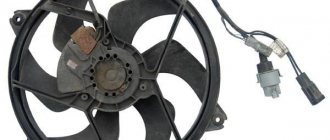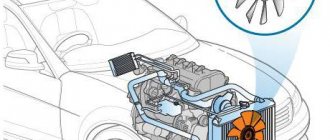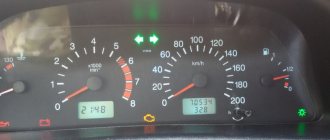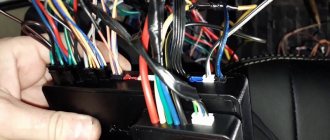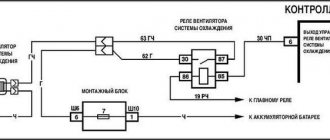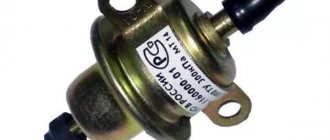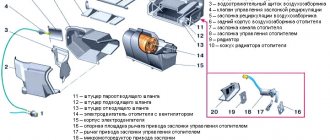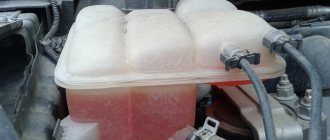The engine cooling system of a modern car is a complex mechanism equipped with passive and active components. Chevrolet Niva fan relays, responsible for turning on and off the specified elements.
Fuses help the electronics turn active cooling on and off to reduce powerplant temperatures.
System structure and principle of turning on fans
- The radiator and engine block are looped into a single system using pipes. Between them there is a rheostat - a damper with a temperature-sensitive element inside.
- When a certain temperature is reached, the damper opens and the liquid begins to circulate in a large circle.
- If passive cooling fails, the engine temperature rises. The head cooling fans come into play. When the temperature limit is overcome, the DTOZh sends an impulse to the BC.
- The processed signal closes the relay and the fan turns on. To improve system performance, the devices are paired. Dubbing helps prevent overheating if one of the devices breaks down. At the same time, the connection diagram for active coolers implies their simultaneous and separate activation.
The Chevrolet Niva interior heater fan is also used to cool the engine. Part of the system has a slight effect on the temperature, but in an emergency it can affect the operation of the engine.
Purpose and design
This is a module designed to be included in the on-board circuit of a motor that consumes high current. The fan motor is powered by electricity with a current of 20-35A, which is unacceptable for inclusion in a low-voltage control system - the wiring will melt. The Niva has only three relays, two for the left and right fans separately and one common. Each device has its own number in the on-board network. The principle of operation and purpose of the relay is relevant for cars of all types 2004, 2010, 2021 and other years of production.
Inside, the relays have an identical design. There is a low part, a transformer and a high part. Also two pairs of contacts, one normally closed, the second open. When a pulse is applied to the lower part, a magnetic field is formed on the windings, and the contact group on the high side closes - power is supplied to the fan motor.
The cooling screw operates in two modes. When the engine heats up to 99 degrees Celsius, the first fan is turned on, after passing the 101⁰C mark, the second one is connected. If the system cannot cope, the motors switch to higher speeds.
Fan relay diagram
The figure shows the power supply circuit for the electric fans of the cooling system of the installation. Design elements are presented by numbers.
- 1/7 – left and right fan motors;
- 2 – additional power relay;
- 3 – fuse;
- 4 – power controller;
- 5 – auxiliary resistor;
- 6/8 – main relay for turning on the right and left electric motor, respectively;
- A/C – negative/positive battery terminal;
- B – to the main ignition relay.
Additional block under the glove box
Located under the glove box on the passenger side.
| Number | What is he responsible for? |
| 1 | Additional relay (turns on the right electric fan through an additional resistor at low rotation speed) |
| 2 | Fuse (50A) protecting the power circuits of the additional relay and the right electric fan relay |
| 3 | Fuse for the fuel pump (fuel pump) (15A), protecting the power circuits of the electric fuel pump relay |
| 4 | Fuse (15A) protecting the controller's constant power supply circuit |
| 5 | Right electric fan relay |
| 6 | Left electric fan relay |
| 7 | Fuel pump relay |
| 8 | Main relay |
| 9 | Fuse (50A) protecting the left electric fan circuits |
| 10 | Fuse (15A) protecting power circuits switched on by the main relay |
| 11 | Controller |
Pulley fan sensor
The coolant temperature sensor plays the role of supplying a pulse to turn on the fans. When a certain temperature is reached, the device sends a signal to the ECU and the fans are activated. In versions where the BC is located in the cabin, you can make adjustments to the sensor response threshold.
Purpose and functions
The device has a single role - to prevent boiling of the coolant and overheating of the power plant. Thus, turning on at a certain moment, the part equalizes the temperature of the engine and stabilizes its behavior.
Operating principle and location
The sensor works as follows.
- The temperature-sensitive sensor is programmed to pulse at a certain temperature.
- When the threshold is reached, the sensor sends a signal to the ECU and the first fan turns on.
- If the motor temperature rises further, the second relay is activated and the remaining fan is connected.
Job
The Shniva cooling system has two active cooling elements. There is a fan for the heater radiator and the main heat exchanger. The following information is relevant for cars of 2010 and other model years.
Fuses are responsible for the correct, stable operation of devices. Fuse links will protect the device from power surges and short circuits.
Pulley fan fuse: where is it located?
Located in close proximity to the corresponding relays. The stove insert is located in the main mounting block under number F18. A 25 amp fuse protects multiple circuits at once.
Photo gallery
Opening the unit cover
Fuse box with cover folded down
Tweezers for removal are clearly visible below
Fuse pulled out with tweezers
Possible malfunctions and their causes
If the fans do not turn on on time, the problem may be hiding in the following places.
- Relays or fuses have blown.
- DTOZH does not work correctly.
- The wiring of the device is damaged.
- Incorrect ECU settings.
- The fan motor is damaged or shorted.
Checking the functionality of the sensor, relays and fuses
The DTOZH is responsible for the operation of the fans; it is easy to check.
- Prepare a thermometer, multimeter, kettle or bowl of cool water.
- Immerse the sensor in a container and put it on fire, at the same time immerse the thermometer in water.
- When passing thresholds of 5 degrees, you should connect the multimeter to the sensor in resistance mode. At the same time, record the data.
- After heating the water to a boil, take the last measurements and compare the results with the reference table below. If the device indicators differ by more than 10% from the standard, the sensor is changed.
Forced activation of cooling fans
To make this possible, car enthusiasts install an additional switch into the device circuit and power it directly from the battery. The operation of the electronics is disrupted and the on-board computer may generate an error.
To fake the device, users on the network recommend using a circuit. A relay and a forced switch are added here.
Replacing the Fan Relay
Due to the simplicity of the design, the procedure is performed according to a standard scenario. Access to the mounting block is opened, the terminal of the relay contact group is disconnected. Next, the device is unscrewed from the panel and replaced with a new one.
Price
Depending on the manufacturer, the cost of the relay ranges from 50-90 rubles per unit. Fuses are considered consumables and cost between 10-15 rubles/piece.
The Chevrolet Niva is an SUV. It has 5 passenger seats and runs on 95 gasoline. A huge advantage is that it is all-wheel drive, has high cross-country ability and has compact dimensions.
To maintain thermal conditions, the car is equipped with a cooling system. In order to maintain the optimal temperature in the vehicle, the Chevrolet Niva manufacturers have provided a cooling system. The most important part is the fan. It is designed to supply air through the radiator core. If the cooling fan breaks down, the machine overheats due to the accumulation of excess warm air inside. This vehicle, unlike other models, has two fans, which complicates the operation of the entire system. This article will tell you what to do if the cooling fan on a Chevrolet Niva does not turn on.
It is enough to simply determine if the cooling fan is broken:
- the temperature arrow will be in the red area;
- The cooling system and fan will not function.
If the cooling fan does not turn on on a Niva Chevrolet car, it is necessary to identify the cause of this phenomenon and eliminate it in the future.
Possible reasons
Before repairing or replacing the cooling fan on a Chevrolet Niva, it is necessary, as already noted, to understand the reasons why this problem could occur. The first step is to inspect the front panel fuse. As a rule, it is located in the mounting block, on the passenger seat side. Two fuses take part in the air cooling process. At the same time, if the right one breaks down, both stop functioning, and if the left one breaks down, the right one still works.
The mounting block contains three relays. Each of them is responsible for a different speed of the cooling fan. If the low speed relay burns out, then the fan only works at maximum power. At the same time, by setting it to a low speed, it will heat up. There is also another additional fuse in the car that supplies power to the relay. If it malfunctions, the entire system will fail completely.
Guides
- Car manuals, instructions, repair and operation manuals for cars 24 views
- BMW error codes 22 views
- Mercedes error codes 19 views
- Ford car repair and operation manual 15 views
- Fuse and relay box Nissan Primera P12 from 2002 to 2007 14 views
- Repair and operation manual for VW cars 13 views
- Fuse and relay box in Opel Vectra B from 1995 - 2000 12 views
- Honda self-diagnosis 11 views
- Location of diagnostic OBD connector for Citroen 11 views
- BMW car repair and operation manual 11 views
Causes of malfunction
The first thing you should pay attention to when the system is not working is the state of the fuses, which are located under the front panel, on the passenger side, in a special mounting block. A pair of fuses are responsible for the cooling operation; if the right one fails, then both fans stop working, and if the left fuse blows, then one element can continue to operate.
In addition, the mounting block has three relays that are responsible for operating the fans at different speeds. And if the relay responsible for operation at low speeds burns out, then the cooling system works correctly only at high speeds, and at low speeds the engine begins to heat up. Power is supplied to the relay through a special fuse, which can also fail, causing system failure.
Failure of temperature sensors also affects proper cooling operation. They are located on the engine. They operate when the desired temperature is reached, one when it reaches 90 degrees, and the second when it reaches 101 degrees. It is recommended to start checking with them, this is done this way: the connector is disconnected from the electric motor, and power is supplied to them directly through the battery; if the electric motor is running, then the reason is in the sensors.
If after checking everything, fuses, relays and sensor are in order, you should pay attention to the fans.
Tips for motorists
The favorable thermal regime of the Chevrolet Niva SUV engine is supported by a cooling system, in which two serviceable fans play a significant role, providing the required air flow through the radiator core. If the fans fail, the cooling system cannot cope with removing excess heat from the engine, and it begins to overheat. Due to the fact that the number of fans on the Chevrolet Niva has been doubled, the electrical circuit for turning them on has become more complex than on conventional passenger cars.
If the temperature gauge needle is near the red part of its scale, and the system fans do not turn on, then you will have to stop and start searching for this malfunction. To do this, you will need to remove the cover of the additional mounting block located under the front panel (below the glove compartment) in the area where the front passenger's feet are located. There are two fuses protecting the electrical circuits of the fan motors. If the fuse protecting the circuit of the right electric motor blows, both fans will not turn on, and if the second blows, only the left fan .
In the same block, there are three relays that are responsible for turning on the right fan at low and high rotation speeds and turning on the left fan at high rotation speed . The additional relay should operate when a control signal is applied to its terminal No. 86 from terminal No. 46 (ECM). In this case, voltage will be supplied to the fan motor terminals through a resistor. If the resistor burns out or this relay fails, the low speed fan work .
Forced activation of cooling fans on Niva Chevrolet
If you watched this video, then don’t try to write your stupid comments, that’s not why I uploaded it.
Checking and removing fans
To understand whether they work or not, you need to disconnect the connector from their motors, and connect a lamp to the wires through which voltage is supplied; we do the same with the sensor; if both lamps light up, then the problem is in the fans.
To remove them you need to do the following:
- Disconnect all wires
- Removing the upper pipe
- Removing the bumper
- If there is an air conditioner, bend the tubes (this must be done carefully, as they may burst) or drain the freon (filling it back will not be cheap), then remove the air conditioner radiator.
- You need to loosen the nuts on the radiator casing
- Tilt the radiator so that you can remove the fan unit
- Unscrew the bolts that secure the block and remove it
After removal, it is recommended to immediately replace both with new ones, since there is a possibility that a little time will pass and the second element will fail and all replacement work will need to be done again. You can do this procedure from below, but you will need special equipment, and you will need to move the engine ten centimeters back, which is very labor-intensive.
Everyone knows that modern cars have a water engine cooling system in their design, which allows many times to increase the service life of not only the engine, but also the entire mechanism as a whole. The Chevrolet Niva also has a radiator in its design that is filled with coolant. This liquid circulates through the system, thereby cooling the car engine. But the engine temperature exceeds 100 degrees, so if this liquid is not cooled, it will soon turn from cooling to heating. This is precisely why there is a radiator cooling system, the operation of which is carried out by a fan. But since the Chevrolet Niva is equipped with a powerful 1.7-liter engine, two fans are used to cool the radiator. In this article, we will look at how these devices work, or rather, what is the main element of turning on these devices on a Chevrolet Niva SUV.
How to change fuses?
To change the fuse links in the Niva Chevrolet fuse box, you need to understand the electrical circuit of the car. A failed fuse can be identified visually or using a tester. To do this, turn on the device in the closed circuit sound test mode and install the probe tips on the fuse contacts.
Test procedure and tweezers
The replacement itself, for example, a windshield wiper fuse with a rating of 20 A (position F9 on both blocks), is carried out as follows:
- Open the block cover.
- Find the failed insert.
- Take it with tweezers and pull it out of the nest.
- A fuse of the same rating must be installed instead. The use of inserts of a higher rating can lead to burnout of the unit and electrical wiring, as well as to a vehicle fire. Using parts with a lower rating will also not protect the circuit, since such an insert will immediately burn out.
- Turn on the circuit in which the insert was replaced. If re-burnout occurs, then the problem is in the elements of this circuit.
- Place the tweezers in their original place and close the lid.
The process of replacing one of the fuses is shown in the video from the Remgar channel.
Fan switching principle
The cooling fan is powered by a constant voltage of 12 V from the battery. They turn on when two sensors located in the engine reach a certain temperature. So, when the first sensor reaches a temperature of 99 degrees Celsius, it is triggered, which causes the first fan to turn on. It has two rotation speed positions - high and low rotation speeds. When the second sensor reaches a value of 101 degrees, then, accordingly, the second device turns on. Thus, the cooling devices of the Chevrolet Niva engine are briefly activated. But we are interested in what role such a small device as a relay, of which there are three on the Chevrolet Niva, plays in this process.
Relay purpose and design
The relay is designed for switching large load currents. This is a rather complex formulation, so in simple terms, a relay is necessary in order to be able to control electrical circuits where there are large currents. The electric motor of the cooler consumes direct current, the value of which is 20-30 amperes, which means that if it is included in the control circuit (where small currents pass), then all the electronics will fail (the wiring will melt). That is why such an important control element is installed in the design of cars.
Externally, the product is a plastic base, inside of which the mechanism itself is located. There are five (four) contacts on the back side of the base. They are the basis for including a relay in the control circuit.
Inside, the relay mechanism is presented in the form of a coil with a core - it is also the basis for closing the circuit contacts. In the photo below you can see the appearance of the Chevrolet Niva product.
The principle of operation of the device and its placement on the Chevrolet Niva
On the front part of the product there is a diagram of the arrangement of contacts, according to which we will consider its principle of operation.
Contacts "85" and "86" are the coil terminals.
General contact “30” - without voltage present on the winding, is always in the closed position to contact “87a”. In turn, contacts:
- “87a” – normally closed;
- “87” – normally open.
It is to these contacts that the power cables from the fan motor are connected.
When power is applied to contacts “85” and “86”, the coil relay is activated. Thus, contact “30” opens from “87a” and closes to “87”. Thus, power is supplied to the electric motor of the device. The activation process takes a fraction of a second.
So, when the temperature in the engine rises, the sensor is triggered and sends an impulse to the control circuit. In turn, voltage is induced in the circuit, which is not supplied by the relay, but it turns on the direct cooling device.
A relay is a replaceable part that, if it fails, requires replacement, but not repair. Some craftsmen are trying to repair them, but there is no need for this, since one product costs from 50 to 80 rubles (depending on the manufacturer).
For Chevrolet Niva, it is recommended to use a relay made in Russia. They are the optimal solution for VAZ family cars.
Before replacing the relay, you will need to find it, because by design it is a small plastic box. Where are the fan relays on the Chevrolet Niva? To answer this question, it is worth noting that there are two cooling devices on the Chevrolet Niva, so the corresponding relay is responsible for the operation of each.
So, having discovered a malfunction in the car’s cooling system, it is worth paying attention to the suitability of the relay. But first they must be removed from the installation site. To do this, you need to open the right front door of the Shevik and look from underneath at the dashboard. It is there, under the cover of the mounting block, that the fan and fuel pump control relays, as well as the fuses for these devices, are located. In the photo below you can see where the control switches are located: right and left, as well as the low speed fan.
To remove the device from its seat, you need to pull it out of the installed socket. To do this, grab the product with one hand and pull. After removing it, do not rush to buy a new relay, as the problem may lie elsewhere. To do this, it is worth checking its performance.
About miscellaneous...
Rules of communication in the forum
Before you ask a question! How to correctly ask questions in the forum and use site materials.| Moscow time 18:38:33 | Your local time | Vladivostok time 01:38:33 |
| Author: Nortfull (5.141.213.—) Date: 22-09-15 04:18 Colleagues, I ask for help again! There is a book on repairing the Sheva Niva, there are all the diagrams, even how to check the generator using an oscilloscope. It is written about the fans that they do not require maintenance, and that’s it! Tell me where to look for something, maybe a diagram? Last time on the forum they immediately identified the cause of the cabin fan and there was no need for a diagram. Thanks in advance! |
| Author: Glot (185.82.177.—) Date: 22-09-15 04:19 First, short-circuit the wires that go to the radiator, if it works, then change the sensor. True, I don’t remember exactly whether it has a sensor on the radiator or on the engine. |
| Author: s494 (89.179.219.—) Date: 22-09-15 04:44 Northfull wrote: > Closed; does not work! =======Everyone doesn't work? when applying voltage to each? Drive both motors at the same time. Nonsense. I can't believe it. If the shniva is an injector, then they are controlled by the brain. Go for diagnostics, if this is the case. Because they are turned on through a resistor and separately. And you, it seems to me, cannot connect the “+” and “-” to the wires of each fan yourself. |
| Author: Nortfull (5.141.213.—) Date: 22-09-15 04:49 Yes, it’s not a problem to connect, you can install a relay and use your brains. Well, I think that after the brains there should be a relay and a fuse. |
| Author: Borno (5.18.155.—) Date: 09/22/15 04:52 Remove the connector from the second overheat sensor!!! Don't close it, but remove it! The fans should start working at the second rotation speed. Unscrew the sensor, change it, clean the place where it enters the block. (dirt and foam sticks there). Well, first check the relays and fuses (the unit is in the PASSENGER’s feet). I eat oysters on the third Shevik.-)) |
| Author: Nortfull (5.141.213.—) Date: 22-09-15 04:54 Grigorievich wrote: > Remove the connector from the second overheating sensor!!! > Don't close it, but remove it! > The fans should start working at the second rotation speed. > Unscrew the sensor, change it, clean the place where it enters the block. > (dirt and foam sticks there). > Well, first check the relays and fuses (the unit is in the PASSENGER’s feet). > I eat oysters on the third Shevik.-)) Got it. I'll try, thanks already. |
| Author: Nortfull (5.141.213.—) Date: 22-09-15 04:58 Northfull wrote: > Grigorievich wrote: > > > Remove the connector from the second overheating sensor!!! quoted1 > > Do not short-circuit, but remove! > > The fans should start working at the second rotation speed. Where is the second sensor? I have one in the middle of the radiator. filmed doesn't work. |
| Author: s494 (89.179.219.—) Date: 22-09-15 05:01 Surely... you should go to an electrician for diagnostics. I don't know, maybe something shorted out in you or there was a surge in the voltage... and the signal began to be given by Moscow when it was much more than a hundred. And the diagnostician will give you 95-96, and everything will be fine. To be honest, although I understand little about auto electrics, I still go to a diagnostician. At the same time, he will check the entire engine in the winter, you will know what and how. |
| Author: Borno (5.18.155.—) Date: 09/22/15 05:01 Top on the block, under the thick pipe. The connector is directed towards the right headlight. |
| Author: s494 (89.179.219.—) Date: 09/22/15 05:03 There should be two sensors on the engine, one shows the temperature on the dashboard, the other sends the temperature to the brain. |
| Author: Nortfull (5.141.213.—) Date: 22-09-15 05:05 s494 wrote: > No wonder... you should go to an electrician for diagnostics. > I don't know, maybe something shorted out in you or there was a surge in the voltage... and the signal began > to be given when it was much more than a hundred. There was a problem with the generator, three tablets burned out from 12 to 18 volts. The US has posted a new generator. |
| Author: Nortfull (5.141.213.—) Date: 09/22/15 05:09 Tomorrow I’ll find and check the fuses and relays. What needs to be taken apart, where should I look? |
| Author: s494 (89.179.219.—) Date: 22-09-15 05:10 Northfull wrote: > s494 wrote: > > > Surely... you should go to an electrician for diagnostics. > > I don't know, maybe something shorted out in you or there was a surge in the voltage... and the signal > began > > to be given when it was much more than a hundred. > There was a problem with the generator, three tablets burned out from 12 to 18 volts. USA new > generator posted. ======= Didn’t you go for computer diagnostics after that? Well, here's the possibility of a malfunction! It can eat more now, and the lead will go astray... and anything else that the computer manages. |
| Author: Nortfull (5.141.213.—) Date: 09/22/15 05:18 Where do you live? Where am I? I'm afraid of these home-grown car mechanics like hell. It’s better to do it yourself, with your own hands. My neighbor in the garage had a damaged engine, sent it in for repairs, it took a month and a half to repair it, he already put in 20 thousand, in short, the US tells him he needs a new engine. and the shniva drove only 65 thousand. , |
| Author: Nortfull (5.141.213.—) Date: 22-09-15 05:24 I also have a bitter experience; - I gave the hydraulic tensioner to change, after which the oil was squeezed out of the engine (not cheap) and the vibration control stopped working. |
| Author: s494 (89.179.219.—) Date: 22-09-15 05:30
|
| Author: Nortfull (5.141.213.—) Date: 22-09-15 05:30 Grigorievich wrote: > I eat oysters on the third Shevik.-)) Grigorievich Please tell me about the chain, I can’t get rid of the clattering of the chain, it makes a clatter, then it doesn’t, with periods, I changed the tensioner 2 times, well, it doesn’t make a clatter for a month, then again I’ve driven about 50 thousand , what is the problem, is it in the chain or tensioners or such spare parts? |
| Author: Nortfull (5.141.213.—) Date: 22-09-15 05:37 s494 wrote: > Well then, the alternative is to look for relays and supply voltage from a sensor installed > in the radiator or from a switch to the panel. > > The sensor can be installed in a pipe inserted into the cut in the upper radiator hose... > But this is a collective farm of collective farms... I already thought about this, our winter is so severe, the fans can never turn on during the winter, the radiator is wrapped in odil, the engine is covered with It’s cold, but other times I go fishing in the snow from my waist up, and they don’t subside there, they work all the way. |
| Author: s494 (89.179.219.—) Date: 22-09-15 06:30 Our diagnostics of the sov-injector costs 500 rubles. They tell you everything about the engine, they even calculate the wear of the timing belt (on 14k). |
| Author: Slavyanin (—.broadband.corbina.ru) Date: 09/22/15 06:49 I very much doubt that the vehicle’s program or settings have gone wrong. I’m curious about the belt, what’s being calculated? And it will probably depend on the controller. |
| Author: s494 (89.179.219.—) Date: 09/22/15 07:01 By opening the valves, probably... I don’t know. Maybe they hit my ears. But the belt really had a real problem. |
| Author: PUKH (37.79.248.—) Date: 09/22/15 08:54 Check the fuses and relays, located at the feet of the right front passenger, under the glove compartment. When you remove the block from the T sensor, which gives a signal to the brain, both Carlsons are triggered (do this first). As for the hydraulic timing chain tensioner - throw it out and install an automatic timing chain tensioner - “Isay” |
| Author: Judge Dredd (78.25.120.—) Date: 22-09-15 09:04 Somehow I didn’t touch on this point... According to the diagram above, there is only one temperature sensor, it should be located somewhere in the cylinder head area... About what sensor on are we talking about the radiator???... |
| Author: PUKH (37.79.248.—) Date: 22-09-15 15:42 Temperature sensors on the engine - 2 pcs. One is located above the spark plugs of 3-4 cylinders, 1 wire fits, works for the device on the panel - we don’t need it . The second one is located next to the thermostat, 2 wires fit, this is what you need, see the link under No. 1, when you remove the block from it, the computer sees an error and turns on both Carlsons = start by removing the connector from this sensor. Link. |
| Author: Alexander Kst (—.176.59.117.243.tele2.ru) Date: 22-09-15 15:57 The clatter of the chain on classic chain engines cannot be eliminated for a long time by replacing the same chain or tensioner. It is necessary to change the sprockets along with the chain. Old sprockets roll a new chain 500 km away. |
| Author: Bubble67 (Vesely Poselok) (—.broadband.corbina.ru) Date: 22-09-15 16:10 On the last five-door car, which has electrics similar to Shniva, I neutered the standard system, cut a tee into the upper pipe and screwed it into it fan switch sensor from Audi-80. It has exactly the same thread as our large one from 03, but controls two fans, turning them on in series. A tee for a sensor of this type is sold freely. Power is supplied directly from the battery through a separate 30A fuse. And this not a collective farm of collective farms, but the simplest one, respectively. efficient and reliable design. |
| Author: SAA (—.ve.mrsk-yuga.ru) Date: 22-09-15 16:24 To prevent the chain from chattering, keep the oil level at the maximum mark, but it is better to install a mechanical automatic tensioner. |
| Author: Nortfull (213.87.240.—) Date: 22-09-15 16:51 POOH wrote: > Temperature sensors on the engine - 2 pcs > One is located above the spark plugs of 3-4 cylinders, 1 wire fits, works for the device > on the panel - we don’t need it. > The second one is located next to the thermostat, 2 wires fit, this is what you need, see the link > under No. 1, when you remove the block from it, the computer sees an error and turns on both Carlsons > = start by removing the connector from this sensor. > Link. I removed the sensor, it hissed something, but the fans did not turn on, I disassembled the glove compartment and found the block relay, the fuses were intact. |
| Author: Nortfull (213.87.240.—) Date: 22-09-15 17:22 It looks like something with a resistor was applied to the relay control terminal - the first vent. They didn’t spin on the second and the third worked. Where is the resistor located? |
| Author: PUKH (5.141.193.—) Date: 22-09-15 17:29 It is not the sensor that needs to be removed, but the connector from it. ……..Up on the block, under the thick pipe. The connector is directed towards the right headlight.... There are no sensors on the radiator or you already have a lot of them. |
| Author: Nortfull (5.141.215.—) Date: 22-09-15 20:13 Judge Dredd wrote: > On the casing, between two fans... And I thought it was a sensor. Thanks, I'll go spin it now. [email protected] #$%^sky tablet inserts its own words. |
| Author: Nortfull (213.87.240.—) Date: 22-09-15 21:25 Yes, they don’t have a 7 Ohm resistor, that’s normal. I removed nothing from the thermostat sensor. It turns out that the first relay is constantly on, the second turns on the non-pump, the second and third fans. |
| Author: Nortfull (213.87.240.—) Date: 22-09-15 21:40 I found the low speed relay for the right fan, it is separate, the signal was sent, it worked, now it turns out there is no signal coming out of the brain? |
| Author: Simple (217.118.93.—) Date: 22-09-15 21:47 Listen to POOH, he wrote correctly, the fuses are under the glove compartment. There's a healthy red one there, most likely it. |
| Author: Nortfull (213.87.240.—) Date: 22-09-15 21:58 Does it protect the living ones, the fans are working, there is no signal for the fan relay to be turned on. |
| Author: Judge Dredd (78.25.120.—) Date: 22-09-15 22:11 I hope that you perform all actions with the ignition on, or even better with the engine running???... For even with the ignition simply on, but Without a signal about the motor running, the control unit may not issue a command to turn on the fans... |
| Author: Nortfull (213.87.240.—) Date: 22-09-15 22:24 The ignition is on! It should work without the engine running, I'll try to start it now. |
| Author: Nortfull (213.87.240.—) Date: 22-09-15 22:35 Judge Dredd wrote: > Because even with the ignition simply turned on but without a signal about the engine running, the > control unit may not issue a command to turn on the fans... The main motor started working, but the motor started up. Well, thank you! All that remains is to check the sensor, the question is: how? |
| Author: Nortfull (213.87.240.—) Date: 22-09-15 22:38 I went to collect the glove compartment, but it was raining outside, and my favorite boat was in the garage, unlucky for the cars. |
| Author: Judge Dredd (78.25.120.—) Date: 09/22/15 22:53 Northfull wrote: > The sensor remains > to be checked, the question is: how? ======================= Well, if you’re in the garage and on your knees, then you stupidly warm up the engine and watch the temperature gauge so as not to boil, and monitor the turning on of the fans... If they don’t turn on consistently, or turn on late, change the sensor... |
| Author: Nortfull (213.87.240.—) Date: 22-09-15 23:05 I disassembled another unit in the Chevy with my own hands, practically only one motor and a front gearbox remained. And then I already sorted everything out. |
| Author: PUKH (5.141.194.—) Date: 09/22/15 23:36 So your propellers didn’t work, maybe simply because the motor didn’t heat up. T sensor above spark plug 4 cyl. Maybe he’s lying and the temperature on the panel is wrong, tighten the terminal on it, in your mind you need to go to the diagnostics, then run both Carlsons from the computer and look at the T of the screws working on the computer (software) and in fact. |
| Author: Nortfull (213.87.240.—) Date: 23-09-15 01:01 POOH wrote: > So your propellers did not work, maybe simply because the motor did not heat up. > T sensor above spark plug 4 cyl. maybe he’s lying and the temperature on the panel is wrong, > tighten the terminal on it, in your mind you need to do diagnostics, then run both > Carlson from the computer and see the T of the screws working on the computer (programmatically) and in fact. Yes, we need to stop by, first we need to find where we have this diagnostic. Thank you. |
| Author: Nortfull (5.141.20.—) Date: 25-10-15 22:31 And Shniva has become again! The fuel pump, which I had already successfully replaced, does not work, but no such luck, it turns out the “+” does not come. It’s already happened three times before, I couldn’t start it, it would sit and then work, but no way. The fuel pump relay works, “+” goes away, but does not come. Please tell me! Where to see? |
| Author: Judge Dredd (78.25.120.—) Date: 25-10-15 22:48 Well, it’s not very difficult either... If the power goes out from the relay (note that after turning on the ignition this lasts a few seconds), and to the pump doesn’t reach, then you need to look for a break/bad contact... Sometimes it’s easier to throw in a new wire without bothering... |
| Author: Nortfull (5.141.20.—) Date: 25-10-15 23:21 I bought a wire, but I’m interested in where is the break? Maybe the signal is old, I installed a new one and blocked the starter. |
| Author: Judge Dredd (78.25.120.—) Date: 25-10-15 23:41 Well, if you are interested, look for it...)) Looks like you have the diagram, look at how the wire goes... Relay/fuse/mounting block... Where then it moved away/rotted... The exact location cannot be determined from the tilipon.... |
| Author: Nortfull (5.141.21.—) Date: 26-10-15 03:14 Tell me, who knows where to look for the connector block, according to some diagrams No. 30-31, it seems to me that all the fuss is there! |
| Author: Judge Dredd (78.25.120.—) Date: 26-10-15 03:57 Either I’m blind, or the screen on the laptop is small, or the quality of the picture is such that I can’t even distinguish all the numbers in the circles... (( But it seems to me that the connector you need is in the mounting block... It makes sense to *screw* everything there, perhaps contact will be restored... |
| Author: s494 (89.179.23.—) Date: 26-10-15 06:12 Was: you turn on the ignition, the motor in the tank hummed, after five seconds it chimed and turned off? Look where there was a click when turning it off. |
| Author: s494 (89.179.23.—) Date: 26-10-15 06:22 Yes, Tolya, I didn’t read it. (Well, connect the wire “+” going from the relay to the motor. |
| Author: Nortfull (5.141.20.—) Date: 26-10-15 06:46 s494 wrote: > Yes, Tolya, I didn’t read it. ( > Well, connect the wire “+” going from the relay to the motor. I want to do that, as a backup option, but I want to find the problem. |
| Author: Nortfull (5.141.214.—) Date: 26-10-15 17:53 I connected the fuel pump directly and the car does not start. I found a melted lambda sensor connector. |
| Author: Nortfull (5.141.20.—) Date: 27-10-15 20:00
|
| Author: Judge Dredd (188.168.252.—) Date: 28-10-15 01:47 Somehow your repairs are going in the wrong direction...(The other day there was only a broken wire to the pump, now everything has gone out and burned out... I’m afraid that it’s impossible to do without a *specially trained person* on site... |
| Author: Nortfull (37.79.109.—) Date: 28-10-15 02:59 I found a “jamb”, there was no contact in the controller connector, I soldered the wire, oh, luckily, it started. |
| Author: Nortfull (37.79.109.—) Date: 28-10-15 04:08 Judge Dredd wrote: > Well, okay... ) > As I understand it, the relay initially did not work, although you wrote the opposite... I apologize, I confused the relay, I screwed myself and people. I can’t understand why the oxygen sensor connector melted, maybe it fell on the manifold from the previous owner, the car is 2003. |
| Author: Nortfull (5.141.214.—) Date: 28-10-15 20:30
|
| Author: Judge Dredd (188.168.252.—) Date: 29-10-15 02:10 Northfull wrote: > installed the boiler for one thing, follow but > “Vibasto”, included the “Vibasto” pump in the circuit, installed a small charger > device. ============================= Can't get through the text...( |
| Author: Nortfull (5.141.214.—) Date: 29-10-15 03:11
> Nortfull wrote: > > > installed the boiler for one thing, follow the > > “Vibasto”, included the “Vibasto” pump in the circuit, installed a small charger > > device. > ============================ > I can’t comprehend the text...(I’ll attach a photo here, maybe it’ll be clearer this way: |
| Author: Nortfull (5.141.214.—) Date: 29-10-15 03:25
> USA drew it, now you can heat the car with either a Vibasto or an electric boiler. not sticky: |
| Author: Nortfull (213.87.248.—) Date: 30-10-15 00:00 Just looked at their website for boilers that are 50 rubles more expensive than ours in the store. I wonder why the official one is more expensive than the regular one here too? |
| Author: s494 (—.broadband.corbina.ru) Date: 30-10-15 02:29 Not about boilers. Do you have enough battery charge on your generator? I put Link in the winter. . Of course, our winters are not cold, but you measure the voltage with a tester when the engine is running, it seems 13.6 volts. You turn on the headlights - 13.4. Few. Now without consumers there is 14.6 volts, you turn on the stove and headlights 14.4 volts. More interesting. I used to solder a diode into the gene, but now I have stopped. This thing that I just installed has adjustment. In summer you can change the voltage. Installation takes 10 minutes, no need to remove the gene. Price 390 rubles in the magician. |
| Author: Nortfull (5.141.21.—) Date: 30-10-15 03:15 Interesting topic, should I try it on? Last year the battery began to run low, I replaced it and this one started to lose its mind, it turned out that the car had problems with the generator, I replaced two regulators and nothing helped. By the way, on mine the generator is (when viewed from the front) on the left. I spat, bought a new one, the guy suggested, it’s 300 more, but it gives out -120A (China) instead of 80A. I installed it and everything is fine, there are no drawdowns, everything is smooth, but the battery is already dying. There is a gel 60A, but it is larger, it sits on the metal without a stand. and the launcher is small. |
| Author: s494 (—.broadband.corbina.ru) Date: 30-10-15 03:23 On Shniva gene 9402.3701-01 I have one too. I installed the regulator for him. Second from top by Link. |
